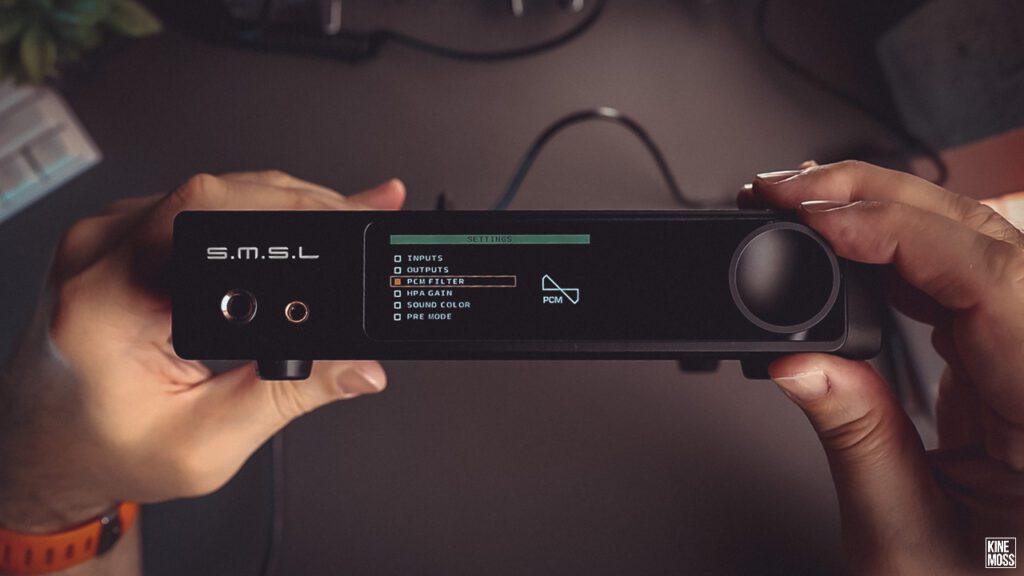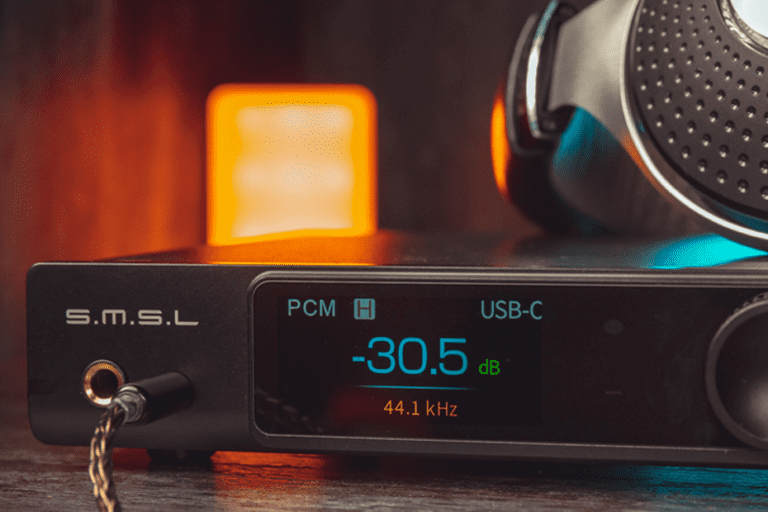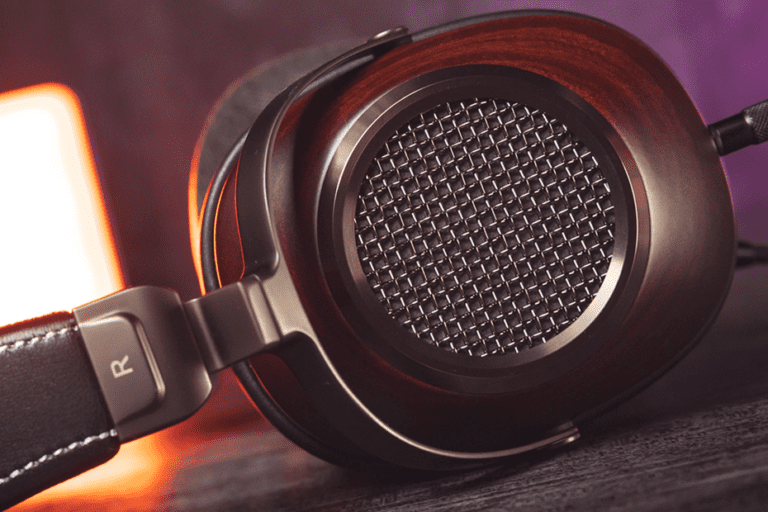Hello, I’m Alexander, and today we are talking about S.M.S.L RAW-MDA1 desktop DAC and headphone amplifier.
S.M.S.L RAW-MDA1 is based on dual ESS ES9039Q2M DAC chips and six OPA1612A op-amps. It supports PCM decoding up to 768kHz at 32 bits and DSD512 and MQA. The device has 6.35 mm single-ended and 4.4 mm balanced headphone outputs and provides 2.5 Watts of output power at 16 Ohms and 1.7 Watts at 32 Ohms. Besides that, it has Bluetooth 5.1 connectivity and supports a lot of codes including LDAC. In addition, it has 4 digital inputs and a built-in power supply. There’s a lot to explore, but let’s start with the unboxing first.
Disclaimer: Shenzhen Audio kindly provided the unit for today’s review. As always, this review reflects my thoughts and opinions that are based on my experience with this product. Check this article if you want to learn more about my review methodology.
The device comes in a large carton box, and the front of the box has branding and a model name.
In the box:
- S.M.S.L RAW-MDA1 desktop DAC/AMP
- Power cord
- USB Type C to Type A cable
- Bluetooth antenna
- A remote control
- User manual
- And a warranty card

Design & build
The device has a body made from anodized aluminum, and it feels solid. The finish looks and feels great too. The length of RAW-MDA1 is 189 mm, the width is 179mm, and the height is 45 mm. The unit is quite hefty and it weighs 1kg. The metal case gives it a sturdiness and the ability to shield the device from external electromagnetic interference.
On the front of the unit, there are 6.35mm and 4.4mm headphone outputs, a large color display protected by tempered glass and a volume knob.
The XLR balanced outputs, RCA unbalanced outputs, two coaxial inputs, two optical inputs, a Bluetooth antenna socket, a USB Type-C connector, a power socket, and a power button are located on the back of the unit.

On the top of the unit, there is a little RAW-MDA1 sticker.
At the bottom of the unit, there are four rubber feet. Overall, the unit feels very solid and I’m pleased with the build, product design, and choice of materials.
The remote control that comes with the unit is S.M.S.L. RC-8C which also comes with some other SMSL products. It has a power button on top, followed by menu navigation buttons. Then we have the source selection button, the FN button that I used to switch between headphones and line-outs, and a mute button. You can also assign a different function to the FN button and you can do it from the main menu. And finally, we have volume buttons that change the volume in the 0.5 dB steps.
Technical specifications
THD+N (@1kHz) (A-WT): is 0.00005, SNR is 132 dB for XLR outputs, 127 dB for RCA outputs, and 122 dB for headphone outputs. The output impedance for line outs is 100 Ohms and the output impedance for headphone output is near 0.
If you are familiar with SMSL products, you already know that they have excellent measurements and S.M.S.L RAW-MDA1 is no exception.

According to the specs, the maximum output power is 1.7 Watts per channel @ 32 Ohms and 2.5 Watts per channel @ 16 Ohms. These are very impressive figures, and this unit will probably drive 95% of the full-size headphones currently on the market.
S.M.S.L RAW-MDA1 can decode PCM up to 768Khz at 32 Ohms, as well as DSD512 and MQA. It’s also mentioned that it supports MQA-CD technology, which in my understanding is a way to unfold the digital stream coming from an external CD player and MQA CDs (which I personally never had any experience with) so I’m currently looking more into this functionality.
The Bluetooth input supports SBC, aptX, aptX HD, and LDAC, so SMSL got us covered.
I was mainly testing S.M.S.L RAW-MDA1 with my Windows-based machine and used Roon for FLAC files and Tidal for lossless streaming. Setting up the unit is easy. Just download the latest drivers from SMSL, connect it and you are ready to go.
Functionality
S.M.S.L RAW-MDA1 is mostly just a plug-and-play device, but there are some options that you can access via the menu system and remote control.
When you switch the device on, the screen will show you the current file type, connection type, volume, and sampling rate.

The volume wheel is very smooth and has clicks. Each click increases or decreases the volume by 0.5db. The volume wheel also has a secondary function and acts as a menu button when pressed. The menu is quite extensive, but fortunately very well structured and easy to learn.
The input option allows you to select one of the 6 inputs, which are USB-C, Bluetooth, Optical one, coaxial one, optical two and coaxial two.
The outputs menu option allows you to configure the configuration of the outputs.
PCM filters option allows you to cycle between 7 built-in DAC filters
The HPA gain option allows you to switch between low and high gain modes
Liked this review? Read more DAC/AMP reviews here
Sound color option is a fun way to change the sound and there are 10 different presets that you can experiment with.
The pre-mode option allows you to switch the line outputs between a fixed volume or a variable volume that you control with a volume knob.
The FN key function option allows you to change what the FN button on the remote will do.
DPLL option allows you to set a jitter

USB mode option switches the device between UAC1 and UAC2
The UI style option lets you switch between two UI styles – the universal one and graphics one. I prefer the universal one myself.
The dimmer option allows you to set a screen timeout in seconds
The brightness option allows you to set the display brightness
The last function on the menu is a Reset which eventually resets the device to the factory defaults. Overall, I like the menu system here. It’s clear, fast, and easy to learn.
S.M.S.L RAW-MDA1 pairings & sound impressions
Before we start, I need to mention that I don’t believe that DACs can have a significant impact on the sound. However, the amplifier section of the DACs can still introduce some changes to the sound. To me, RAW-MDA1 sounds organic, natural, and transparent, with a solid black background and no coloration to the sound.
The balanced headphone output on the front panel is for convenience only, which means it doesn’t provide additional power but is handy in case you already have headphones and IEMs with the 4.4mm cable termination.
With all of my IEMs, I have run the unit in the low-gain mode. With demanding IEMs and quiet recordings, I rarely increased the volume past -16 dB and still had a lot of headroom left. I also didn’t notice any audible distortion or noise with sensitive IEMs, which was good, too.

The next important aspect was how it would drive my full-size headphones. I tried it with 10 different headphones I had at hand while making this review, ranging from 16 to 300 Ohm.
The S.M.S.L RAW-MDA1 has driven most of my sensitive full-size headphones in the low gain mode with ease. Testing the unit with 250 and 300 Ohm dynamic headphones and low sensitivity planar magnetic ones required switching the unit to the high gain mode, as there was not much headroom left in low gain mode.
In the high gain mode, I rarely increased the volume past -14 dB, and I still had some power left to drive my demanding headphones to absurd levels of volume.
Overall the S.M.S.L RAW-MDA1 has shown fantastic results and has driven all the pairs in my tests with authority providing great dynamics, sound realism, wonderful instrument separation and a fantastic detail retrieval.
What did I like?
- Good build
- Dual ES9039Q2M chips with impressive performance
- Transparent and natural sound presentation
- Solid black background
- Two gain modes
- A lot of output power
- 6.35mm and 4.4mm headphone outputs
- Remote control
- RCA and XLR line outputs
- Bluetooth connectivity, including LDAC support
- 4 digital inputs
- Built-in power supply
- And a fantastic price-to-performance ratio
What I didn’t like?
Well, I don’t think this unit has any real cons. But if you want me to be very picky, I will mention that I would prefer a metal volume knob, instead of the plastic one, and a more sleek front panel, without the protruding display, but that’s just me.

I think S.M.S.L RAW-MDA1 is an ideal all-in-one solution, no matter if you are looking for your first advanced desktop DAC/AMP or if you have several other devices with digital outputs and you need to have a single DAC/AMP component in this system. To me, it strikes the perfect balance between price, performance, flexibility, and output power. With all the features and connectivity options it brings to the table, I think it’s an amazing desktop DAC and AMP and I can highly recommend it.
And that concludes my review for today. If you want to see more content like this, consider subscribing to my YouTube channel. Thank you for joining me, and until next time, goodbye!
🛒S.M.S.L RAW-MDA1 DAC/AMP on Amazon
🛒S.M.S.L RAW-MDA1 DAC/AMP on Aliexpress
** As an Amazon Associate I earn from qualifying purchases. Some of the links in my reviews are affiliate links, which means at no extra cost to you, I will make a small commission if you click them and make a qualifying purchase.
____



